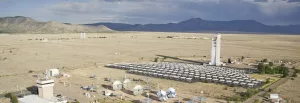New Mexico will host a new concentrated solar power plant that could kill coal, gas, and nuclear energy all at once
Fans of concentrating solar power have weathered a storm of criticism over the years, but the dream just won’t die. They speak of a 100-megawatt facility that can deliver electricity 24/7, just like a nuclear power plant but without the risk factor and the fancy price tag, too. That’s asking a lot, but the US Department of Energy has latched on to a new ceramic-based technology that could deliver the goods.
New Mexico will host a new concentrating solar power plant aimed at killing coal, gas and nuclear energy all at once (photo courtesy of US Department of Energy)
The Ups & Downs Of Concentrating Solar Power
For those of you new to the topic, concentrating solar power plants don’t use conventional photovoltaic panels to collect solar energy. Instead, they deploy a field of specialized mirrors that bounce sunlight onto a central point. The solar energy heats up a store of specialized oil or molten salt, which is then piped to a generating station where it can run a turbine.
If that sounds expensive, inefficient, and complicated, it can be. Even so, concentrating solar power has been catching on elsewhere around the world. The advantage is that the energy-absorbing medium, whether oil or salt, also acts as a built in energy storage reservoir, enabling the turbines to keep spinning long after the sun goes down.
Getting a foothold here in the US is a different kettle of fish. The Obama administration showcased a group of five CSP plants in the Southwest, but the program didn’t stimulate much follow-on interest among private investors.
The Energy Department went back to the drawing board in 2015 and came up with a program called CSP: APOLLO. The program aims to identify new technologies and systems that can provide for high-temperature operation, defined as more than 720°C, the idea being that higher temperatures can result in efficiency improvements while cutting costs. The official goal is a minimum of 50% thermal-to-electric conversion efficiency, which the Energy Department describes as “dramatically more efficient than current technology.”
One Weird Trick Could Make Concentrating Solar Power Happen: Ceramics
Oddly enough, the Trump administration continued to support the Energy Department’s R&D work on high temperature concentrating solar power, despite the former President’s oft-repeated promise to save coal jobs and a stab at creating more nuclear energy jobs, too.
During Trump’s first year in office, CleanTechnica caught wind of an Energy Department article extolling the benefits of CSP facilities. The article mentioned something about $62 million in funding for a new program called Generation 3 CSP Systems, and that’s where things get interesting.
Gen 3 CSP focuses on identifying new high-temperature technologies that have passed muster at the laboratory scale, and assembling them into systems that can be field tested under various conditions.
“This includes the development of a test facility that allows diverse teams of researchers, laboratories, developers and manufacturers to remove key technological risks for the next generation CSP technology and enable the reduction of the levelized cost of energy (LCOE) for electricity generated by CSP to 6 ¢/kWh or less, without subsidies, by the end of the decade,” the Energy Department explains.
By 2018, some of the new Gen 3 CSP projects began crossing the CleanTechnica radar on a regular basis, including an innovative “falling particle” system based on gravity and ceramics, developed by Sandia National Laboratories. We also had a chance to speak with the experts about another project involving new alloys for high-temperature CSP facilities.
A New Dawn For CSP
Another Energy Department focus of attention is the Bill Gates CSP venture Heliogen, which burst out of stealth mode in 2019 with a goal of operating at 1,000 degrees centigrade.
The last time we checked into Heliogen, they were on track to install their CSP system to help cut emissions at a boron mine in California.
That was back in 2021. If you have any breaking news about the project, drop us a note in the comment thread. Meanwhile, it looks like Sandia National Laboratory is off to the races. Last week, the Energy Department announced that it selected Sandia for a $25 million award aimed at building, testing, and operating a new CSP system at the agency’s National Solar Thermal Test Facility in Albuquerque, New Mexico.
The new concentrating solar power system culminates a total of $100 million in funding for high temperature CSP. It will showcase Sandia’s falling particle technology, which can operate at temperatures above 800°C.
“These particles can be used to transfer and store heat or power a supercritical carbon dioxide (sCO2) turbine. If successful, this type of solar power plant could provide 100 megawatts of power continuously, around the clock, at low cost,” the Energy Department enthused, adding that their electricity-plus-storage goal is 5 cents per kilowatt hour.
Wait, What Particles?
DOE stacked up the particle approach compared to other systems and identified several key advantages.
“After this review, DOE determined that particle-based systems require fewer components and are less complex to operate compared with liquid- and gas-based systems,” they explained. “Additionally, particle-based systems need relatively few high-cost materials to collect and transport thermal energy. These factors could increase plant availability and reliability and enable simpler plant construction and commissioning.”
DOE also noted that the particle-based technology could help decarbonize industries that rely on high process heat of more than 800° Celsius, in addition to generating electricity.
As for the particles themselves, they are based on aluminum oxide and register a diameter of just 300 micrometers each.
“The heated particles are then stored in an insulated bin before passing through a particle-to-working-fluid heat exchanger. The heat exchanger’s working fluid will simulate a high-efficiency Brayton cycle using supercritical carbon dioxide (sCO2) with an exit temperature of 720°C,” DOE explains, “Then the cooled particles are collected and moved back to the top of the receiver via a bucket elevator or skip hoist.”
That still sounds complicated and expensive, but apparently not so. If you caught that thing about supercritical carbon dioxide, that’s part of the reason. Supercritical carbon dioxide (sCO2) is the liquid form of CO2. When deployed to run a turbine, sCO2 can provide for efficiency gains and a much more compact footprint, leading to reduced costs.
The Energy Department anticipates that the falling-particle concentrating solar power setup could yield 100 megawatts of low-cost power around the clock.
If private investors were skittish about concentrating solar power in the US before, they may change their tune after 2024, when the Sandia system is expected to be up and running.
Meanwhile, Heliogen seems to be going through a rough patch, but earlier this month the company announced a new CEO, Christie Obiaya, who has a plan for turning things around. In addition to her experience in energy-related project development, Ms. Obiaya is an engineer with a B.S. in Chemical Engineering from MIT.
Follow me on Trainwreck Twitter @TinaMCasey.
Find me on LinkedIn: @TinaMCasey or Mastodon: @Casey or Post: @tinamcasey
Photo (cropped): New Mexico will host a new concentrating solar power plant to showcase falling particle technology, courtesy of US Department of Energy.



